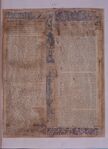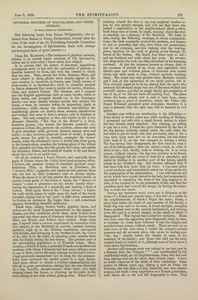 |
vol. title: Miscellaneous Scraps from January 1st 1878 vol. period: 1875-1878 pages in vol.: 153 |
Abnormal Spectres of Wolves, Dogs and Other Animals
The following letter from Prince Wittgenstein, who returned from Russia to Vevey, Switzerland, directly after the close of the work of the St. Petersburg Scientific Committee for the Investigation of Spiritualism, deals with strange psychological facts of great interest:—
Dear Mr. Harrison,—The instances of phantom animals, alluded to in several recent numbers of The Spiritualist, induce me to state what I know about that subject.
It is curious that the nature of abnormal apparitions corresponds more or less with the nationality of persons or families haunted by them, and with the country in which they are seen. Thus, among the Celts, Romans, Slavs, and races related to them, ghosts more usually appear in the open country, in meadows, in forests, near lonely crosses or cross-roads, or in churchyards; while in countries peopled by Saxon elements they seem to prefer old castles, churches, ruins, and isolated houses. The German, and I suppose also the English apparitions, such as nuns, monks, white or black ladies, and gnomish dwarfs—as in the Leiningen family—are more usually tutelary spirits, who protect the house, or warn its inmates before an impending death or misfortune; while among the aforesaid nationalities the manifesting ghosts are mostly sham animals, mischievous and wicked, and seem to have a mission only to frighten or harm. The only exception to this rule known to me is the Domovoi (literally, “The One of the House”), a kind, harmless gnome, who haunts the Russian peasant’s cot, preserves it from fire, protects the children, causes the cows to give abundant milk, prevents diseases among men and cattle; it also, however, plays all kinds of tricks; it upsets pails, causes the girls to stumble, entangles the horses’ manes, hides the drunkard’s boots to hinder him from going to the brandy-shop, smashes the looking-glass of the village flirt, splashes hot soup into the greedy one’s face, and causes the furniture, dishes, and household vessels to fly and dance about the room in an awful way.
Of all the countries I know, France, and especially those parts of France where the Celtic blood predominates, offers, I believe, the greatest variety of abnormal spiritual manifestations. Thus, in Morbihan and in Finisterre, the “Grande Bete” a gigantic and luminous bull, pursues those who are late on their homeward road on stormy nights. When the moon is in its last quarter the wanderer meets, in certain lonely parts of the forest or heath, the “Meneur de Loups” a man or phantom—no one knows exactly what— having the appearance of a shepherd, and leading a flock of wolves. Then again there is the “Loup Garou” a frightful wolf, which jumps by night upon the back of the lonely traveller, urging him to run until he falls down exhausted. In Corsica an enormous fly, bigger than a calf, sometimes appears, foreboding dreadful epidemics.
Black dogs, shaggy horses, bucks, gigantic hares, and wolves are the most frequent apparitions in the steppes of Russia, and Slav traditions about them seem to have been imported into those parts of Germany where in former times Slavs (as Wends and Sorbes) have settled. Some years ago, I myself tried a curious experiment in connection with this subject, at the Richthof, an ancient, isolated hunting pavilion, high up in the Hessian mountains, surrounded with forests, and belonging to my brother-in-law, the Count of G., who is in the habit of spending some months there with his family during the hot season. The greatest part of the surrounding population is of Wendish origin. Mme. Courtin, a friend of mine, a powerful French non-professional medium, with whom I formerly had had many sittings, came to see us there, and on the same evening we two had a seance. I had previously mesmerised her to sleep, for the somnambulic state increased her medial power to a high degree. After some efforts to obtain a written communication, she left off in great perturbation, stating that she was disturbed by a big, horrible, phosphorescent white buck, who kept, running round the house, or climbing up the walls to the. roof, staring at her with wicked, glaring eyes. When I next morning related the fact to my very sceptical brother-in-law, he was greatly amazed, and told me that there was indeed a superstition in the neighbourhood about a white buck being seen at times, by night, running about the roof, or standing on a chimney of the Richthof. We tried in vain, during the following evenings, to obtain communications; the buck constantly worried the medium, and became at last so powerful, that she, even when not mesmerised, and in our company, saw him rushing over the bowling green, standing on the roof, or glaring at her through the leaves of the bushes. She heard him bleat (and so did I and my brothers) and walk about her room. My servant, who slept under the roof, was often disturbed by his tramping overhead. At last the nuisance became so strong, that, in the presence of several of us, doors and cupboards were thrown open and reclosed, pieces of furniture were tossed about, and bells made to ring, without anybody touching them. The house was only quieted when Madame Courtin and I had, at the injunction of our spirit guides, left it. They strongly urged us to do so, stating that the spirit who assumed the aforesaid shape was one of the most wicked and powerful nature, and that he might finally get possession of one of us, if we did not leave off exciting him. The place where the house stands now is said to have been, many centuries ago, a place of execution, where the Vehme (the Secret Tribunal) punished great criminals; therefore it is easy to presume that the spot may still be haunted by evil spirits.
Another case within my recollection is the following:— Some eleven or twelve years ago, while residing at Warsaw, I presented my wife with a small Scotch terrier, to which she had become much attached. One evening, on calling to pay her a visit, I found her quite disturbed by the fact of her dog having suddenly rushed under the sofa, when she had tried to pat its head; she had previously seen it for a long time lying near her on an arm-chair, but had taken little heed of it, as she was occupied in writing a letter. The dog having thus disappeared, she first tried [to coax it out of its hiding-place; then she seized a stick, in order to drive it out; and, finally, took to looking for it in every corner, without success; the dog was nowhere to be found. She accordingly left the room to look for it elsewhere, and ended by finding it in another part of the house, quietly asleep on her brother’s lap. Her brother affirmed that it had been with him more than an hour. I was then rather a good medium, and immediately asked one of my spirits for the explanation of the phenomenon. I was told that an evil spirit, which bore a great hatred to the lady, had momentarily succeeded in assuming the form of her dog, hoping to be able, if she touched it, to get possession of her, and that her guardian spirit had averted the design, by forcing the sham-dog to elude her touch.
During my residence many years ago in Bohemia, at the house of a friend now passed away, I was told of a castle in the neighborhood, of which I forget the name, where, a short time before the death of any member of the family, a black dog was said to be seen, in broad daylight, emerging from a postern door in the ancient battlements, and trotting down the road to a ruined chapel, in the shade of which it disappeared. This legend has existed for centuries. Those who have seen the apparition have frequently tried, in vain, to overtake it; some have followed it into the chapel, and searched every corner, without result. There are now (or at least were, at the time when I visited the country) several peasants and old servants alive, who swore to having seen “the dog” shortly before the deaths of some of the members of the family; and those who told me the story seemed firmly to believe in it, although none of them knew a word about Spiritualism.
<... continues on page 5-66 >
Editor's notes
Sources
-
London Spiritualist, No. 198, June 9, 1876, pp. 271-2

